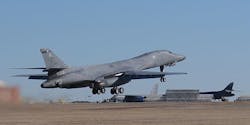Air Force starts taking delivery of B-1 bombers with biggest avionics upgrade in jet's history
TINKER AIR FORCE BASE, Okla., 24 Jan. 2014. U.S. Air Force jet bomber squadrons have begun taking delivery of the latest versions of the venerable Boeing B-1 Lancer jet bomber, which has the most extensive avionics upgrade in the aircraft's long history.
The Air Force this week received the first B-1 bomber upgraded with the Boeing Integrated Battle Station, which integrates three major aircraft modifications -- an updated front and aft cockpit, a new diagnostics system, and a new Link 16 data link to enhance situational awareness and communications for the B-1 crew.
The B-1 was designed in the early 1970s, but the program was cancelled by then-President Jimmy Carter in 1977 shortly after Carter took office. Carter's successor, President Ronald Reagan, reinstated the program in the early 1980s, and the B-1 entered Air Force service in 1986.
Related: Crane Microwave to maintain B-1 electronic warfare components in $12.4 million contract
The aircraft is designed as a supersonic low-level penetrating bomber able to carry nuclear and conventional bombs and missiles. The aircraft uses speed at low altitudes and a sophisticated electronic warfare (EW) system to defeat enemy air defenses.
The first B-1 with the Integrated Battle Station was delivered to the Air Force on Tuesday, and will be based at Dyess Air Force Base, Texas.
The upgrade gives B-1 crews enhanced situational awareness of what is happening in the battlespace around them, in addition to faster and more secure communication capabilities that improve their ability to attack enemy targets.
Related: Air Force chooses crystal oscillators from Syntonic Microwave for B-1B bomber EW system
The Integrated Battle Station replaces several displays with new multi-function color display units, introduce a central integrated test system and a new model of Aircraft Performance Monitoring Computer, new Link 16 networking, and digital flight instrumentation.
The vertical situation display unit portion of the Integrated Battle Station upgrades the B-1's forward cockpit by replacing two obsolete monochrome pilot and co-pilot displays with four multifunctional color displays.
The B-1's new digital data link will give the aft cockpit new digital avionics including a Link 16 data link, which adds line-of-sight capability to the B-1's existing beyond line-of-sight joint range extension applications protocol data link and integrates the JREAP data onto color displays with intuitive symbols and moving maps.
The central integrated test system adds a color display in the aft cockpit and replaces an obsolete computer that continuously monitors the aircraft's performance. It helps ground support personnel troubleshoot B-1 system problems.
Personnel from the Air Force 76th Aircraft Maintenance Group at Tinker Air Force Base, Okla, are installing the Integrated Battle Station equipment aboard B-1 bombers.
The Integrated Battle station upgrades will cost about $975 million and will take about eight years to complete on 61 B-1 aircraft.
Related: Boeing B-1 with FIDL avionics upgrade completes 1st phase of flight test
For more information contact Boeing online at www.boeing.com, or the 76th Aircraft Maintenance Group at www.tinker.af.mil.

